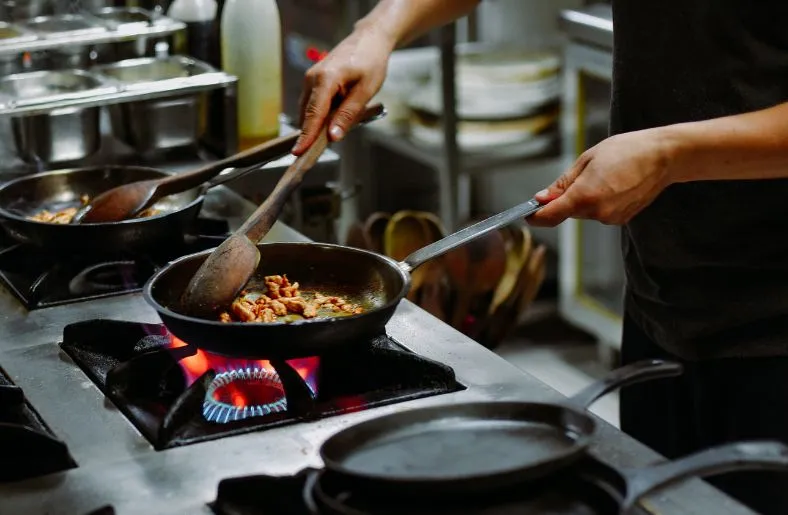Cast iron skillets have been a staple in kitchens for generations, and for good reason. They distribute heat evenly, retain heat exceptionally well, and can last a lifetime with proper care. However, over time, these beloved kitchen tools can develop rust, which not only affects their appearance but also their cooking performance.
In this expert guide, I will walk you through the process of how to clean a rusty cast iron skillet and restore its cooking power, so you can continue to enjoy the benefits of this timeless kitchen essential.
Table of Contents
Importance of Cleaning a Rusty Cast Iron Skillet
Before we delve into the process of how to clean a rusty cast iron skillet, it is crucial to understand why it is important to clean a rusty cast iron skillet. Rust not only affects the aesthetics of the skillet, but it can also impact the taste of your food and even pose health risks.
When rust starts to form, it creates a rough surface that food can stick to, making it difficult to cook and clean. Additionally, rust contains iron oxide, which can contaminate your food and potentially cause health issues if consumed in large quantities. By regularly cleaning and maintaining your cast iron skillet, you can ensure that it remains safe to use and retains its cooking power.
Materials Needed for Cleaning a Rusty Cast Iron Skillet
To clean a rusty cast iron skillet, you will need a few essential materials. Here’s what you’ll need:
- Gloves: It is important to protect your hands while handling cleaning agents and scrubbing tools.
- Steel wool or a scrub brush: These tools will help remove the rust from the skillet’s surface.
- Dish soap: A mild dish soap will be used to clean the skillet thoroughly.
- White vinegar: Vinegar is an excellent natural cleaning agent that can help remove rust.
- Paper towels or clean cloth: These will be used for drying the skillet after cleaning.
- Vegetable oil or flaxseed oil: These oils will be used to season the skillet after cleaning, restoring its non-stick surface.
Having these materials ready will ensure a smooth and efficient cleaning process for your rusty cast iron skillet.
How to Clean a Rusty Cast Iron Skillet: A Step-by-Step Guide
Now that we have the necessary materials, let’s dive into the step-by-step process of how to clean a rusty cast iron skillet:
- Preparation: Start by putting on your gloves to protect your hands. Place the rusty cast iron skillet on a heat-resistant surface.
- Scrubbing: Using steel wool or a scrub brush, vigorously scrub the skillet to remove the rust. Focus on the rusty areas, applying pressure as needed. Rinse the skillet with warm water to remove any loose rust particles.
- Soap and Vinegar: Apply a small amount of dish soap to the skillet, then pour white vinegar over it. Use a scrub brush to gently scrub the entire surface of the skillet. This combination will help remove any remaining rust and grime.
- Rinsing and Drying: Rinse the skillet thoroughly with warm water to remove any soap residue. Dry the skillet completely using paper towels or a clean cloth. Ensure that there is no moisture left on the surface, as this can lead to rust formation.
- Seasoning: To restore the skillet’s non-stick surface, apply a thin layer of vegetable oil or flaxseed oil to the entire skillet, including the handle. Use a paper towel to evenly distribute the oil. Place the skillet in an oven preheated to 350°F (175°C) for one hour. This process will create a protective layer on the skillet’s surface.
- Cooling and Storing: Once the hour is up, turn off the oven and allow the skillet to cool inside. Once cooled, store the skillet in a dry place to prevent moisture build-up.
Following these steps will help you effectively clean a rusty cast iron skillet and restore its cooking power.
Restoring the Cooking Power of a Cast Iron Skillet
How to clean a rusty cast iron skillet is only half the battle; restoring its cooking power is equally important. After cleaning, the skillet may lose its non-stick surface and require re-seasoning. Seasoning involves applying a thin layer of oil to the skillet and heating it to create a natural non-stick surface. This process also helps prevent rust formation in the future.
By re-seasoning your cast iron skillet regularly, you can maintain its cooking power and enjoy the benefits of a non-stick surface.
To season your cast iron skillet, follow these steps:
- Preheat the oven: Set your oven to 400°F (200°C) and allow it to preheat.
- Apply oil: Apply a thin layer of vegetable oil or flaxseed oil to the entire skillet, including the handle. Use a paper towel to ensure an even distribution of oil.
- Bake the skillet: Place the skillet upside-down on the top rack of the preheated oven. This prevents oil from pooling in the skillet and promotes even seasoning. Bake the skillet for one hour.
- Cool and repeat: After one hour, turn off the oven and let the skillet cool inside. Once cooled, repeat the process two to three more times to build up a strong seasoning layer.
By restoring the cooking power of your cast iron skillet through proper seasoning, you can ensure that your food cooks evenly and effortlessly, making every meal a delight.
Tips for Maintaining a Clean and Seasoned Cast Iron Skillet
To keep your cast iron skillet clean and seasoned, here are a few tips to follow:
- Avoid soap: While it is necessary to use soap while cleaning a rusty cast iron skillet, it is best to avoid it during regular cleaning. Soap can strip away the seasoning and affect the skillet’s non-stick surface. Instead, use hot water and a brush to clean off any food residue.
- Dry thoroughly: After cleaning, make sure to dry the skillet thoroughly to prevent rust formation. Place it on the stove over low heat for a few minutes to remove any remaining moisture.
- Apply oil after each use: After each use, apply a thin layer of oil to the skillet. This helps maintain the seasoning and prevents rust.
- Avoid acidic foods: Acidic foods can break down the seasoning layer of the skillet. Avoid cooking highly acidic dishes for prolonged periods in your cast iron skillet.
- Use wooden or silicone utensils: Metal utensils can scratch the surface of the skillet and damage the seasoning. Opt for wooden or silicone utensils instead.
By following these tips, you can ensure that your cast iron skillet remains clean, seasoned, and ready to serve you for years to come.
Common Mistakes to Avoid When Cleaning a Cast Iron Skillet
While cleaning a cast iron skillet may seem straightforward, there are a few common mistakes that you should avoid to maintain its quality and longevity:
- Using harsh cleaning agents: Avoid using harsh cleaning agents, such as oven cleaners or abrasive powders, as they can damage the seasoning and the skillet’s surface.
- Soaking for extended periods: While it may be tempting to soak a rusty skillet to loosen the rust, avoid soaking it for extended periods. Prolonged exposure to water can cause further rusting.
- Scrubbing too aggressively: While it is necessary to scrub the skillet to remove rust, avoid scrubbing too aggressively. Excessive scrubbing can damage the skillet’s surface and remove the seasoning.
- Neglecting proper drying: Ensure that the skillet is thoroughly dried after cleaning. Any moisture left on the surface can lead to rust formation.
- Skipping the seasoning process: After cleaning a rusty cast iron skillet, it is crucial to re-season it to restore its non-stick surface. Skipping this step can result in a subpar cooking experience.
By avoiding these common mistakes, you can ensure that your cast iron skillet remains in optimal condition and continues to serve you well in the kitchen.
Related Guide: Guidelines for Selection of Lubricants (2023-2024)?
FAQs
1. Can I use a dishwasher to clean a cast iron skillet?
No, it is not recommended to clean a cast iron skillet in a dishwasher. The harsh detergents and high heat of a dishwasher can strip away the skillet’s seasoning and promote rust formation.
2. How often should I clean my cast iron skillet?
The frequency of cleaning depends on how often you use the skillet. Ideally, you should clean it after each use to remove any food residue and maintain its seasoning.
3. Can I use oven cleaner to remove rust from a cast iron skillet?
No, oven cleaner is too harsh and can damage the skillet’s surface and seasoning. Stick to the recommended cleaning methods mentioned in this guide.
4. Should I use soap to clean my cast iron skillet regularly?
It is best to avoid using soap during regular cleaning, as it can strip away the seasoning. Instead, use hot water and a brush to remove any food residue.
5. Can I use my cast iron skillet on an induction cooktop?
Yes, cast iron skillets are compatible with induction cooktops. Their magnetic properties make them an excellent choice for this type of stovetop.
Conclusion
Cleaning a rusty cast iron skillet and restoring its cooking power may seem like a daunting task, but with the right materials, techniques, and regular maintenance, it can be easily achieved. By following the step-by-step guide on how to clean a rusty cast iron skillet and incorporating the tips shared in this expert guide, you can ensure that your cast iron skillet remains in top-notch condition, providing you with even heat distribution, exceptional heat retention, and a non-stick surface.
So, roll up your sleeves, gather your materials, and give your rusty cast iron skillet the care it deserves. Soon enough, you’ll be savoring delicious meals cooked to perfection in your revitalized cast iron skillet.

